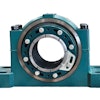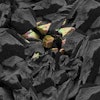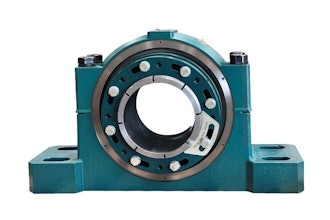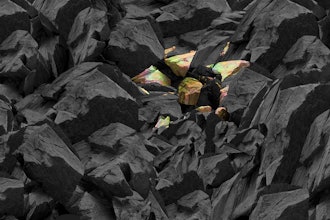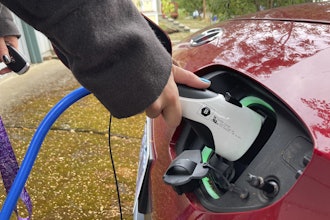PHOENIX (AP) — New, transparent egg cartons are helping Hickman's Family Farms keep cracked or damaged eggs off store shelves.
The plastic container has a hard bottom that holds the eggs in place and is covered by film instead of a lid. Plastic separators come up a couple of inches above the egg so the packages can be stacked.
The Buckeye company began rethinking the classic carton after officials got information from stores that most breaks and spills happen in grocery aisles — where customers open packages to examine the eggs — not at the farm.
The farm gives Costco a full refund for damaged products, so fine-tuning the packages helps Arizona's largest commercial egg producer cut costs. The pilot began April 9. Compared with the same five-month period a year ago, Hickman's saw a 50 percent decrease in breakage at each Costco location with the new cartons.
"If you know you're going to have to take everything back that they (stores) don't want, you want to make sure there's not a whole lot there to take back," said Clint Hickman, vice president of sales and marketing for the company.
Hickman estimated that the farm spends thousands of dollars a week on damaged eggs.
Costco representatives did not return calls for comment.
The packages are being tested at four Costco locations in Scottsdale, Glendale, Phoenix and Avondale, as well as two Fry's locations, 13982 W. Waddell Road, Surprise, and 11425 W. Buckeye Road, Avondale.
One day, the cartons could appear in other U.S. and international grocery stores. The West Valley company ships its products to six other states and two other countries.
The farm, which has been in the Valley since 1944, employs about 250 people in Arizona. Hickman's Family Farms produces more than 2.5 million eggs a day, including those of its farms in Colorado and California.
While other producers have been using plastic egg cartons for years, Hickman said his company's is the first tamper-proof package that is also eco-friendly because it uses less material.
The carton with the clear top costs more for Hickman's to produce than traditional cartons made from cardboard pulp and Styrofoam. Customers pay the same price for eggs no matter which package they choose.
However, if the idea takes off, the long-term payoff for switching to clear cartons might make it worth the initial expense, Hickman said.
Hickman would not discuss the financial details of the pilot program, but said the company is comparing sales of the clear cartons with ones made from cardboard pulp and Styrofoam.
Hickman said a major reason for experimenting with a clear, all-plastic egg carton is food-safety concerns, though food-safety experts say the risk is minimal.
The company goes through several precautions, from soapy scrubbing to ultraviolet-light irradiation, to make sure the eggs are untouched until the customer takes them home. However, customers often touch, switch out or break eggs in the store, which could spread germs through the eggshell to the egg, Hickman said.
That's unlikely, said Jessica Rigler, chief of the Epidemiology and Disease Control Services bureau of the Arizona Department of Health Services.
Rigler said she had never heard of a human contact-related illness outbreak that involved eggs.
Eating raw eggs, however, can be risky, she added.
"If people are not fully cooking the food that they're eating ... or washing their hands, there's always a risk of illnesses," Rigler said.
To reduce the chances of spreading illnesses, consumers should always cook raw eggs, said Roland Mader, administrator of food safety and quality assurance for dairy and eggs in the Arizona Department of Agriculture.
People should avoid recipes that call for undercooked or raw eggs, such as eggnog or certain salad dressings, Mader added.
Fry's agreed to participate in the pilot because "our customers are always looking for new choices," said Pam Giannonatti, community-relations manager.
On a recent store visit, customers' reactions were mixed.
Some, like Tolleson resident Rocquelle Fleeman, 62, were pleased that they can clearly see the eggs without opening the container. Fleeman recently bought a package.
"Sometimes I touch each one, sometimes I touch them on the bottom to see if they're leaking out, because otherwise I don't realize until I get home," she said. "With this one, you can see right through it."
Others, like Avondale resident Mike Jennings, 59, worried that the new package is less durable.
"When you pick it up, it's real flimsy," Jennings said. "When you pick it up (on one end), (the other end) just falls down. ... I wouldn't buy it."
Hickman's is still testing the new package and plans to do a second trial in October, company officials say.
In the first production run, only containers for 18-packs of extra-large eggs were manufactured. Hickman would not say how many were made.
He said the company expects to release a version for the one-dozen packages next month. Those may be sold in other stores, such as AJ's and Bashas'.
"There's no reason to push something on the consumer that they don't want to buy," he said. "We're going to give it at least a couple (of more) months."
If the packaging is successful, Hickman and the product inventor, Geoff Von Der Ahe, hope to integrate the "VonPak" into Hickman's regular production and will sell the packaging to other interested egg companies across the nation.
Van Der Ahe customized the package prototype for Hickman's.
Packaging for cereal, juice and snacks often change, but Von Der Ahe says egg cartons have changed little since the product hit the major retail market.
"It's really kind of archaic," said Von Der Ahe, president of VonPak. "I thought there has to be a better way."
He wanted to find a way to improve the look and design as well as minimize the packages' impact on the environment.
The VonPak design uses 30 percent less material than traditional clam-shell containers. Plus, traditional clam-shell containers often are made with material like Styrofoam, which is challenging to recycle and can take hundreds of years to decompose, he said.
Most metro Phoenix cities will not recycle Styrofoam egg cartons.
Eventually, Von Der Ahe and Hickman plan to create VonPaks using 100 percent recycled plastic.
"I wanted to be able to tell my customers ... throw it in a recycling bin; don't throw it in trash can," Hickman said.
"That's something we do every day at the farm. We try to recycle and reuse everything that we can."


